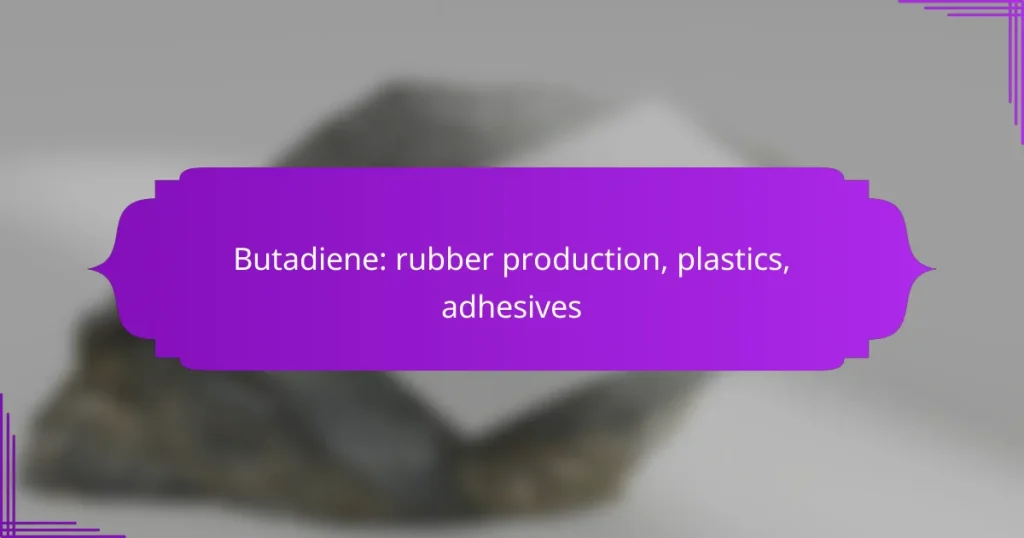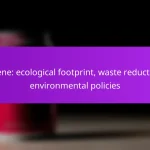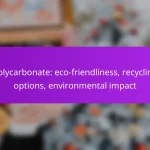Butadiene is a vital compound in the production of synthetic rubber, plastics, and adhesives, significantly contributing to various industries. In New Zealand, it is primarily used to manufacture durable automotive tires and industrial products, enhancing their performance and longevity. Additionally, butadiene’s versatility allows it to be a crucial building block for flexible and impact-resistant materials, making it essential in the formulation of strong adhesives for diverse applications.

How is butadiene used in rubber production in New Zealand?
In New Zealand, butadiene is primarily utilized in the production of synthetic rubber, which is essential for various applications including automotive tires and industrial products. This versatile compound plays a crucial role in enhancing the durability and performance of rubber materials.
Production of synthetic rubber
The production of synthetic rubber from butadiene involves polymerization processes, where butadiene is combined with other monomers to create various rubber types. Common methods include emulsion and solution polymerization, which allow for the customization of rubber properties to meet specific performance requirements.
In New Zealand, local manufacturers often focus on producing styrene-butadiene rubber (SBR) due to its balance of performance and cost-effectiveness. This type of rubber is widely used in tires and other rubber products.
Key manufacturers in New Zealand
New Zealand hosts several key manufacturers involved in the production of synthetic rubber from butadiene. Notable companies include local subsidiaries of international firms, which leverage advanced technologies to produce high-quality rubber products.
These manufacturers often collaborate with automotive and industrial sectors to ensure that their rubber offerings meet local and international standards, contributing to the overall growth of the rubber industry in the region.
Applications in automotive tires
Butadiene-derived synthetic rubber is a fundamental component in the production of automotive tires, providing essential properties such as flexibility, durability, and resistance to wear. Tires made from this rubber can enhance vehicle performance, safety, and fuel efficiency.
In New Zealand, the demand for high-performance tires has led manufacturers to innovate with different formulations of synthetic rubber, optimizing them for various driving conditions and vehicle types.
Environmental impact considerations
The production and use of butadiene in rubber manufacturing raise several environmental concerns, including emissions and waste management. Manufacturers in New Zealand are increasingly adopting sustainable practices to minimize their ecological footprint.
Efforts include implementing cleaner production technologies and recycling initiatives to reduce the environmental impact of synthetic rubber. Compliance with local environmental regulations is crucial for manufacturers aiming to operate sustainably while meeting market demands.

What role does butadiene play in plastics?
Butadiene is a key building block in the production of various plastics, particularly in the synthesis of synthetic rubbers and polymers. Its versatility allows it to be used in the manufacturing of materials that are durable, flexible, and resistant to impact.
Types of plastics produced
Butadiene is primarily used to produce styrene-butadiene rubber (SBR) and acrylonitrile-butadiene-styrene (ABS) plastics. SBR is commonly found in tires and footwear, while ABS is widely used in consumer goods, automotive parts, and electronic housings due to its strength and resilience.
Additionally, butadiene contributes to the production of polybutadiene, which is used in various applications including adhesives and coatings. These plastics are valued for their excellent mechanical properties and ability to withstand harsh conditions.
Major plastic manufacturers in New Zealand
In New Zealand, several companies are involved in the production of plastics that utilize butadiene. Notable manufacturers include Z Energy, which produces various polymer products, and Fletcher Building, known for its construction materials that incorporate advanced plastic formulations.
These companies focus on sustainable practices and often comply with local regulations regarding plastic production and waste management, ensuring that their processes align with environmental standards.
Recycling and sustainability issues
The recycling of plastics containing butadiene poses challenges due to the complexity of the materials and the need for specialized processes. While some types of butadiene-based plastics can be recycled, many end up in landfills, contributing to environmental concerns.
To address sustainability, manufacturers are exploring bio-based alternatives and improving recycling technologies. Consumers can contribute by properly sorting plastics and supporting products made from recycled materials, thus reducing the overall impact on the environment.

How is butadiene utilized in adhesives?
Butadiene is a key component in the production of various adhesives, particularly those that require strong bonding and flexibility. Its unique chemical properties enhance the performance of adhesives, making them suitable for a wide range of applications, from construction to automotive industries.
Common adhesive formulations
Butadiene is often used in formulations such as styrene-butadiene rubber (SBR) and polybutadiene adhesives. These formulations provide excellent adhesion to a variety of substrates, including metals, plastics, and wood. Additionally, they can be modified with other polymers to enhance specific properties like heat resistance or water resistance.
Leading adhesive brands in New Zealand
In New Zealand, several brands are recognized for their butadiene-based adhesives. Notable examples include Selleys, which offers a range of construction and household adhesives, and Bostik, known for its industrial adhesive solutions. These brands often emphasize the durability and flexibility of their products, appealing to both consumers and professionals.
Performance characteristics of butadiene-based adhesives
Butadiene-based adhesives are known for their strong bonding capabilities and flexibility, making them ideal for applications that require movement or stress. They typically exhibit good resistance to moisture and temperature fluctuations, which is crucial for outdoor or high-temperature environments. However, users should be aware that some formulations may have lower resistance to certain solvents, so testing is recommended for specific applications.

What are the economic impacts of butadiene production?
Butadiene production significantly influences economies, particularly in sectors like rubber, plastics, and adhesives. Its contribution to GDP and job creation in the chemical industry underscores its importance in driving economic growth and stability.
Contribution to New Zealand’s GDP
Butadiene production contributes positively to New Zealand’s GDP by supporting various manufacturing sectors. The rubber and plastics industries, which rely heavily on butadiene, represent a notable portion of the country’s industrial output.
As these industries grow, they enhance economic resilience and provide a buffer against global market fluctuations. This growth can lead to increased exports, which further boosts the national economy.
Job creation in the chemical industry
The butadiene sector plays a crucial role in job creation within New Zealand’s chemical industry. Manufacturing processes that utilize butadiene require a skilled workforce, leading to direct employment opportunities in production facilities.
Additionally, the growth of related industries, such as logistics and distribution, creates indirect job opportunities. This ripple effect can significantly enhance local employment rates and contribute to community development.

What are the safety and regulatory considerations for butadiene?
Butadiene is a highly flammable gas that poses various safety and regulatory challenges. Proper handling and adherence to safety regulations are essential to mitigate health risks and ensure compliance with local laws.
Health risks associated with butadiene
Exposure to butadiene can lead to serious health issues, including respiratory problems and neurological effects. Long-term exposure is associated with an increased risk of cancer, particularly leukemia.
Individuals working in industries that utilize butadiene should use personal protective equipment (PPE) and follow safety protocols to minimize inhalation and skin contact. Regular health screenings can help detect any early signs of exposure-related health problems.
Regulatory bodies in New Zealand
In New Zealand, the primary regulatory body overseeing butadiene is WorkSafe New Zealand. They establish guidelines for safe handling, storage, and use of hazardous substances, including butadiene.
Additionally, the Environmental Protection Authority (EPA) monitors the environmental impact of butadiene and ensures compliance with national standards. Companies must adhere to these regulations to avoid penalties and ensure worker safety.

How to choose butadiene suppliers in New Zealand?
Selecting butadiene suppliers in New Zealand involves assessing their reliability, product quality, and compliance with local regulations. Prioritize suppliers with a proven track record in the industry and those who can meet your specific production needs.
Criteria for supplier selection
When choosing butadiene suppliers, consider factors such as production capacity, delivery reliability, and pricing structures. It’s essential to evaluate their adherence to safety and environmental regulations, as these can impact your operations.
Additionally, assess the supplier’s reputation in the market by checking customer reviews and industry certifications. A supplier with strong customer support can also be a significant advantage in resolving any issues that may arise.
Top butadiene suppliers in New Zealand
Some of the leading butadiene suppliers in New Zealand include major chemical companies that have established a presence in the region. Notable names often mentioned are Z Energy and Methanex, which have extensive networks and resources.
It’s advisable to contact these suppliers directly to inquire about their specific offerings, pricing, and terms of service. Comparing multiple suppliers can help you find the best fit for your production requirements and budget constraints.


